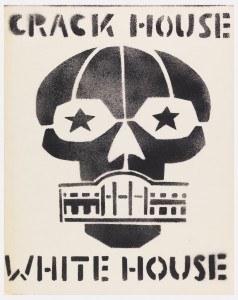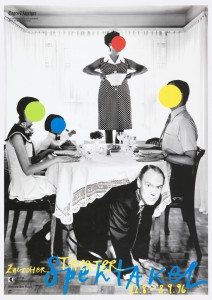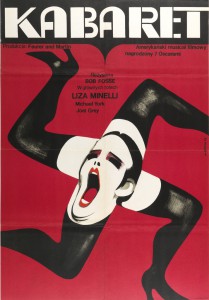The Cooper Hewitt design museum located in the upper east side of Manhattan is a museum exclusively devoted to historic and contemporary design. In there you could find famous artwork such as posters, sketches of Pixar’s animation, even future models of projects and ideas on how to make our New York City a better place. In my visit on the Cooper Hewitt museum there where a lot of art pieces that intrigued me and my interest, which three of this pieces where “Crack House White house,” “Zürcher Theater Spektakel [Zürich Theatre Festivel]” and “Kaberet.”
Poster, “Crack House White house”, 1991:

This is a 61 x 48.4 cm (24 in. x 19 1/16 in) poster created by Seth Tobocman and Peter Kuper. This object was donated by Steven Heller and Karrie Jacobs and catalogued by LSA (Linguistic Society of America). It was made in 1991 and the Cooper Hewitt took position of it in 1993, it was a credited gift of Steven Heller and Karrie Jacobs. Its medium is spray paint on tracing paper, which makes it part of the Drawings, Prints, and Graphic Design department. The poster makes the presidential residence blend into the grin of skull. Its typography is very bold, although it’s very similar to a Sans serif, kind of like a broken up distorted Helvetica, which is excellent with this composition since it screams rebellion over the white house, giving the overall message for why the white house residence blended into the grin of the skull.
Poster, Zürcher Theater Spektakel [Zürich Theatre Festivel], 1996:
This is a 128.1 × 90.6 cm (50 7/16 × 35 11/16 in) poster. It was designed by director Benker & Steiner Werbeagentur AG and made for (as the client) Zürcher Theater Spektakel.it was made in 1996 and the Cooper Hewitt museum acquired it in 2010. Its medium is offset lithograph on wove paper. It is a part of the Drawings, Prints, and Graphic Design department. The concept behind this is an odd event in a family dinner. The mother stands on a chair while the father is chained to a table leg, appearing hopeless to his fate, staring straight at viewer from beneath the table. Blocking the other family members faces with colored dots, which intensified our emotions making it harder to understand what is really going on. The Typography in this poster is beautifully matching with the random dots on the other members of the family. It don’t scream to you, yet it’s very noticeable and it catches your eyes, since it’s in bold colors and its hand drawn.
Poster, Kabaret, 1973:
This is a 83.8 × 58.1 cm (33 in. × 22 7/8 in) poster. It was designed by Wiktor Górka made in 1973 and the Cooper Hewitt acquired it 2010. Its medium is offset lithograph on wove paper, which is printed in black ink (Rze. / 084 / 73.) It is a part of the Drawings, Prints, and Graphic Design department. Wikto Górka, a leading participant in the Polish School of Poster Art, was a master of visual metaphor. Bob Fosse’s 1972 film, “Cabaret,” is set in a German nightclub during Hitler’s rise. In Górka’s visual pun, a strange cast of body parts mixt together to create a single disturbing image. The typography is distracting from the composition, but it also brings balance to it, since this poster was meant for a German nightclub, the letters look as if they were lighten up for a show.





